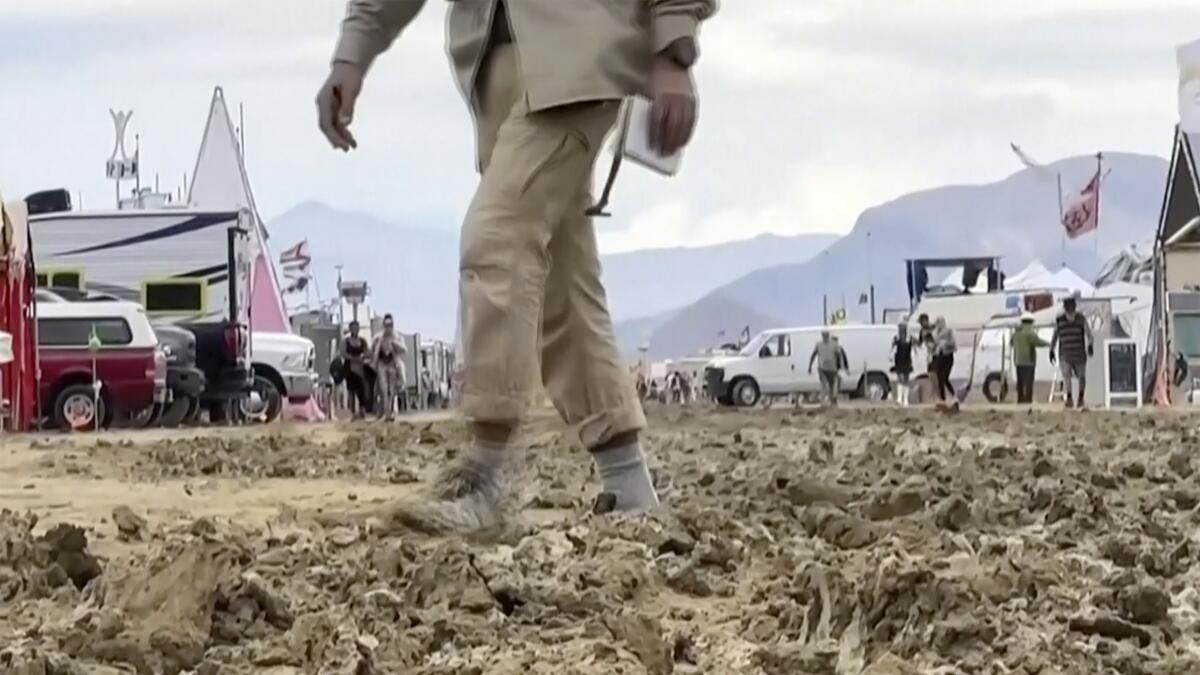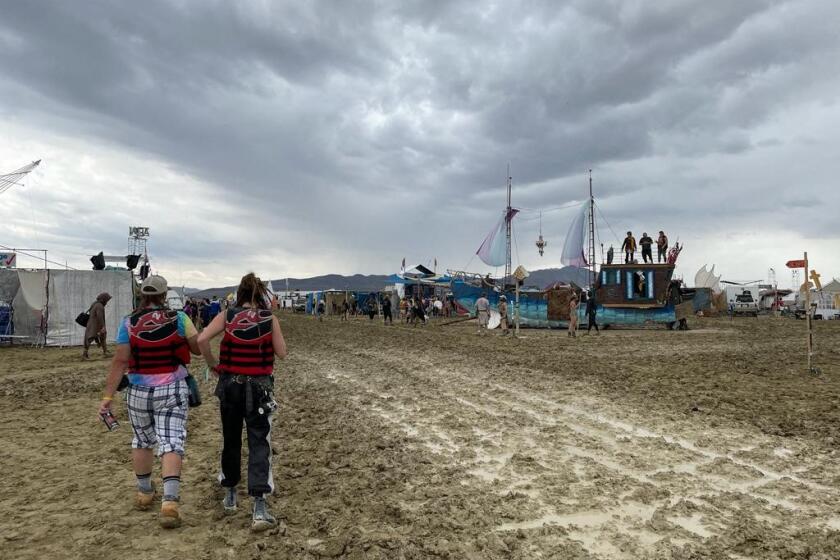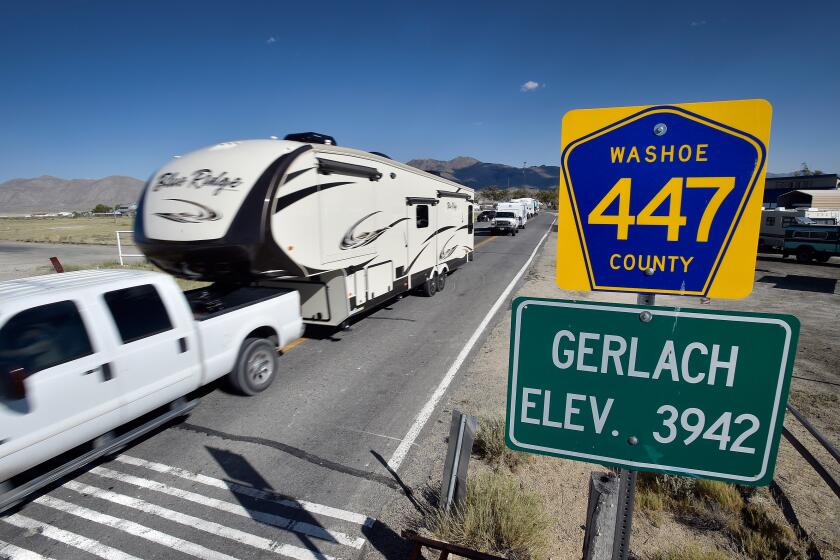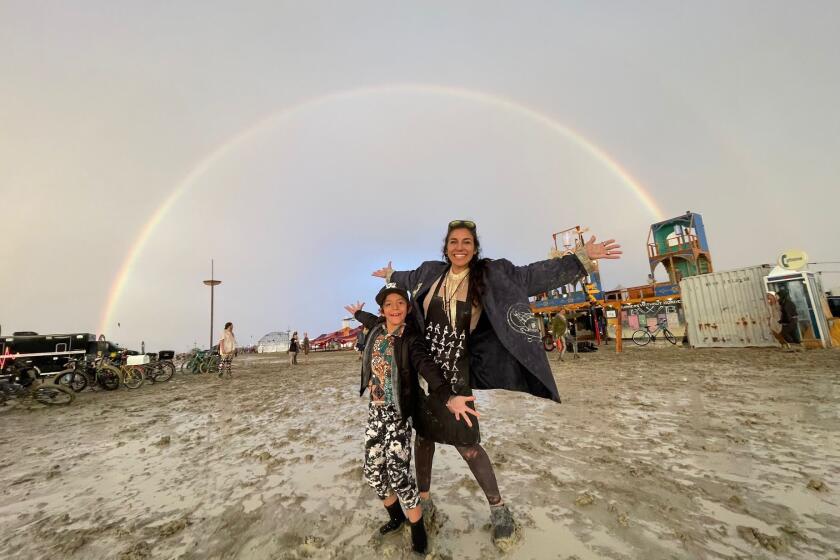Column: The ‘fuss’ over Burning Man proves we care about the wrong people stuck in the mud

- Share via
The stories coming out of Burning Man have been, in a word, terrible.
No one in, no one out. People wrapping trash bags around their shoes to avoid getting stuck in ankle-deep mud. Canceled deliveries of food, water and fuel for generators. A death that’s under investigation. And porta-potties that are full of poop and unable to be emptied.
Indeed, though the “exodus” begins on Monday, more than 70,000 people have been essentially stranded for days in the waterlogged, temporary metropolis of Black Rock City in rural northwestern Nevada.
After a series of storms dumped unexpectedly large amounts of cold rain, organizers of the annual festival were forced to shut the entrance and exit gates.
People at the Burning Man festival in Nevada were told to conserve food, water and fuel and to shelter in place after rain turned the desert to mud. More rain is on the way.
“No driving is permitted until the playa surface dries up, with the exception of emergency vehicles,” organizers advised over the weekend. “Participants are encouraged to conserve food, water, and fuel, and shelter in a warm, safe space.”
Like I said, terrible.
And yet, it has been hard to take all of this drama playing out on the playa seriously. Yes, the internet has predictably gone all in, righteously dunking on the people who paid untold sums for a pilgrimage to the desert only to get trapped in miserable conditions.
But what’s happening is about more than that. In many ways, it’s another uncomfortable reminder of who really has value in this country and who doesn’t.
Consider that, as word spread over the weekend about Burning Man becoming Waiting Man, the Washoe County Sheriff’s Office, Pershing County Sheriff’s Office and U.S. Bureau of Land Management announced they were leaping into action and marshaling their resources to help.
Four-wheel-drive vehicles and mobile cell trailers were brought in, just in case of a medical emergency and so people could call their loved ones and employers. Buses have been deployed to collect people who decided to defy the organizers’ shelter-in-place order and left on foot.
Marian Goodell, CEO of Burning Man Project, told NBC that organizers turned down an offer of assistance from the Nevada National Guard. Even President Biden has been receiving briefings.
Meanwhile, let me tell you about some other people who also recently got stuck in the mud and stranded while camping.
Tracey and Joe.
Jane.
Steven.
I met all of them about a week after Tropical Storm Hilary barreled through Southern California. I had joined Ruth Sanchez of the Dolores Huerta Foundation on a tour of several RV encampments in the desert just outside Lancaster.
For years, she and a dedicated crew of part-time volunteers have been delivering food and water and other supplies to what they describe as a forgotten population in the Antelope Valley — and a growing one, at that.
“We have this encampment,” Sanchez explained, pointing toward clusters of RVs dotting the landscape in seemingly every direction. “But if we go a little further, we have at least another 50, 60 trailers.”
While many in the city of L.A. had moved on after the much-hyped hurricane-turned-tropical-storm had fizzled, people living along these desolate dirt roads, not far from the 14 Freeway in unincorporated Los Angeles County, were still navigating waist-high floodwaters.
Tracey, who uses a cane to get around, told me how, when the rain came rushing into the RV she shared with her boyfriend Joe, he had to pull her and their dogs to safety on a raft made from a hot tub. She can’t swim.
“I woke up, and I was like, ‘Oh my God! Joe, we’re flooded in. We can’t get out!’” she recounted.
The receding water left behind knee-deep mud.
Jane, whom I spotted washing a shirt in a muddy, water-filled ditch, said her RV still had about a foot of water inside. And Steven, who rolled up on a bicycle, told me he fled his RV after he found a rattlesnake swimming inside.
“I’m not going back in there,” he said, shaking his head.
Why these encampments exist, and how much money, aid and attention government officials actually direct their way, continue to be matters of dispute. There’s plenty of finger-pointing and blame-shifting.
But at least while I was out there, most residents said they assumed they were on their own and were acting accordingly.
In Black Rock City, they were not.
Climate and anti-capitalist activists blocked a road leading to Burning Man, creating gridlock and leading to clashes with motorists and tribal rangers.
Burning Man is supposed to be about “radical self-reliance” — no doubt, one reason Goodell, the CEO, chided government authorities for making “such a fuss” over the festival’s predicament.
In a statement on Saturday, organizers said they were “well-prepared for a weather event like this,” and were in “constant communication” with local, county, state, tribal and federal officials. And indeed, several people — several Burners — told my Times colleagues over the weekend that spirits were high.
Karole Holland-Hagino, who was attending her first Burning Man with her son, reported that “everyone is great and everyone [is] adapting.”
Yet, I’d argue that real “radical self-reliance” is what’s happening in the high desert of the Antelope Valley, where food and water must be conserved year-round, and where, without a working generator, the nearest source of electricity is a half-hour walk away.
I’m not sure I’ll ever understand why people are willing to pay to essentially experience what tens of thousands of unhoused Californians experience every single day.
People like Sean Rakidzich, who traveled to Black Rock City from Dallas and told The Times that “adversity will drive away people who think Burning Man is a music festival. A lot of us do believe that this is the burn we signed up for.”
Rainstorms doused the annual festival at Black Rock Desert, but also caused road closures and rescues across Nevada.
Most people who go to Burning Man, according to a survey conducted by organizers and reported by the San Francisco Chronicle, are wealthy. Increasingly so, at that.
Of the 75,000 mostly Californians who made the trip to the playa in 2022, more than half had an annual household income of more than $100,000, including 16% who made $300,000 or more. About 81% identified as white, 10% as Latino, 8% as Asian and only about 2% as Black.
These statistics are basically the exact opposite of California’s unhoused population, which is overwhelmingly low-income, and disproportionately made up of people who are Black and Latino. And increasing numbers of them, unable to afford housing, are living outdoors vulnerable to the weather whiplash of climate change in tents and in RVs a lot more dilapidated than those stuck in the mud in Black Rock City.
My only hope is that once all the Burners return home, they will remember not just the partying, but the hardships they experienced, and develop a bit more empathy for the Traceys, Joes, Janes and Stevens of this state.
Over the weekend, Burner Tara Saylor told my Times colleague Brittny Mejia that no one, regardless of income — except maybe celebrities Diplo and Chris Rock — was going to be able to leave Burning Man.
“Money does not solve disasters like this,” she said.
Maybe not in Black Rock City. But in the Antelope Valley, that’s still an open question.
More to Read
Sign up for Essential California
The most important California stories and recommendations in your inbox every morning.
You may occasionally receive promotional content from the Los Angeles Times.














